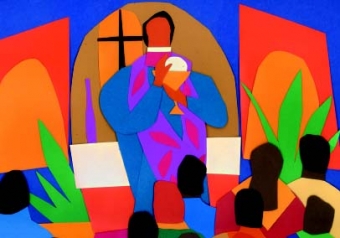No doubt U.S. Catholic Reader C. Wall of Woodstock, Illinois speaks for many when she succinctly sums up what does and doesn't make for a good experience of the Mass. Good: "My family by my side, great homily, with a community I know." And the clinkers? "Poor, long, aimless homilies. Music I can't sing along with."
Add an abiding love for the Body of Christ-which tends to take the form of the Real Presence in older folks, the assembled community in younger folks-and you've got a fairly good snapshot of what nearly 300 survey respondents told us about their own Mass experience. In more ways than one, it's their own presence before the Body of Christ that saves the day for most parishioners-sustaining them in good times and bad, reassuring them in spite of crying kids, bad sound systems, and uninspired recitations of the rituals.
Which is about what you'd expect from a church claiming to be, in true Vatican II parlance, a "eucharistic people." Just as you would also expect to hear readers relate some of the unmistakable "signs of the times" that are challenging our church right now: everything from the exhausted displays of our priesthood shortage to the electronic beeping of pagers that signal the time-starved crowds.
But what you wouldn't expect, perhaps, is such a united uproar over liturgical music. Just what is it about today's harmonics that strikes such a sour note among typical parishioners, among both pew-sitters and choir members alike?
Church music: Too much of it, too little of it. Too old, too new. Too trite, too traditional. Faddish modern fare that can't compete with the timelessness of Gregorian chant. Musicians bent on performance rather than participation. All the distractions of having to stumble through yet another unfamiliar song when so many simply long for a little silence to let everything sink in. It's enough to make you wonder whether the maker of that famous saloon sign had Sunday mornings in mind when he wrote, "Don't shoot the piano player."
Singing praises of Vatican II
"Better hymns. I'd like to see less of the old standards," says Mary Gust of East Grand Forks, Minnesota. "Sometimes the music at funerals is more uplifting than at Sunday Mass," asserts Myra Condon of Shorewood, Illinois. Music, it seems, not only speaks at the level of emotion-the many emotions people have when it comes to either a thwarted or satisfied desire to sing out their differing expressions of faith-but, liturgically speaking, it's also the interstitial fluid that flows in and around all the other elements of the Mass.
If you're unhappy about the homily, you might just get over it by the time you stand in a Communion line. But any annoyance with the music is probably going to get you, coming and going, at the processional and recessional. And probably between the readings and during Communion, too.
But the main chorus on this subject seems to echo a wider concern Catholics have in the wake of Vatican II.
Consider how, for average Catholics, the most celebrated innovation of the Second Vatican Council has been the invitation for them to participate in the Mass.
"There's a feeling of being a worshiping community instead of watching the priest go up there with his back to us and praying in Latin," remember Ted and Helen Johnson of San José, California. "It's like the priest was up there 'performing' on a stage and we were only there as an audience," agrees a reader from Kentucky.
Then, consider how music that's just too removed from the congregation might just as well be in inaccessible Latin as in the vernacular. Jeff Austin of Marshfield, Wisconsin was one of many who sang the blues on this subject. According to Austin, the biggest mistake liturgy planners make is "choosing music that cannot be sung by ordinary people. Music for musicians is nice, but if people are going to participate, then it must be kept simple and familiar."
If people participate? According to our survey, most Massgoers expect to participate, and get peeved when they can't. Or when the musicians take center stage instead of the worshiping community.
Doris Ulrick of Camden, New York gets annoyed with "the choir performing up front, like a stage show." And it bothers James Gossman of Greeley, Colorado enough that he'd like to see "congregational singing with little or no accompaniment--no 'performances' by the choir."
A similar effect happens when planners constantly add new songs to the parish's repertoire, imagining that it's the best bet for staving off boredom. But for everyone who isn't as rehearsed as the parish choir, it's just one more instance of being unable to participate fully in worship.
A Maryland reader was one of several who lamented the "use of so much unfamiliar music. It's tough to sing new songs almost monthly, if not weekly." For Jim Jordan of Santee, California, it's the aggravation of "hardly ever having the same hymns sung twice."
Beauty and the busy
Russ Anton of Oscoda, Michigan seems to speak for many who responded to this survey. "Sometimes I get the feeling that there is some Madison Avenue ad man working with the Catholic Church to keep the Mass 'relevant' and interesting. I don't need that. It's a special opportunity for me to be close to God; it doesn't need either improvement or continuous changes. During the various parts of the Mass, I prefer my focus to be on the significance of that particular part, not on learning or reading a new singing response. All this emphasis on external, observable participation ignores and often detracts from the participation that to me is more important-what's going on in your heart and mind."
Pat Ruggaber of Wheaton, Illinois tends to agree. "There's too much 'busyness.' The Mass is a beautiful prayer in and of itself. In an effort to make it entertaining as well, we lose the beauty in the distractions."
This is where music ministers should sit up and take note. Even though some people said they grew tired of too many "old standards," some of the oldest standards are truly beautiful and can cast a transcendent effect if used as part of a good musical mix. Such as chant. Sister Mary Kenan McGowan, R.S.M. of Grafton, New York joined countless others in "missing some of the grand and beautiful music of the past, such as Gregorian chant and two- and three-part harmony."
"As much as I love the vernacular, I am saddened by the loss of chant," agrees a Colorado reader.
But as William and Mary Shea of Sonoma, California caution, the longing for such traditional touches "does not mean a longing for the old ways" but means, rather, mining the richness of our past, such as the beauty it has held.
Massgoers are simply hungry for more beauty. Vicki Markwell of West Chester, Ohio really misses "the stained glass, bells, and incense. We have a cross, not a crucifix." Jerry Mazenko of Garden Grove, California regrets that there are "no High Masses, no Solemn High Masses, much less pomp and circumstance."
But beauty lies in simplicity, too, our readers seem to indicate, many of whom expressed a weariness with not only music and rituals that were overwrought, but church decoration as well. "We seem to have lost 'Low Masses,'" notes Dennis Winkelsas of Norfolk, Virginia. "Do we really need to sing everything like we're in a participatory musical or opera?"
What could be more simple than silence? It is the antithesis of busyness, after all. Florence Murphy of Warren, Michigan, yearns for "an opportunity for quiet reflection after Communion." Trudy Cranston of Westmont, New Jersey, like many U.S. Catholic readers, laments that liturgists "plan for very little quiet time."
Signs of the times
So imagine how up in arms Massgoers get when what little quiet there is gets pierced by the electronic trill of pagers and cell phones. Yet, according to survey results, this is a growing reality in many parishes. And it's more than simply an assault on the ears, say respondents; it's a clear sign that there's been a diminishing sense of reverence on the part of contemporary worshipers-the number one way, they say, that the Mass has changed for the worse over the years.
J.B. Badgett of Louisville, Kentucky includes "cell phones and pagers, tardiness and leaving early" as part of his modern-day litany of casualness and disrespect. "Beachwear, shorts, T-shirts, and halter tops are now common, too." While casual or downright sloppy attire tops the list of disrespectful behaviors-along with the other quiet-shattering habit of too much casual talking in church-late arrivals and early departures are seen not only as disrespectful but as disruptive.
"The basic problem is that only one third of Catholics attend Mass regularly, and of those who do attend, one third leave immediately after Communion," says Norman Leister of Doylestown, Pennsylvania.
To hear readers tell it, it might well be all those "extras" making Mass too busy that also has worshipers ducking out early.
"Too many announcements about the parish, in general, during weekend Mass" tests the patience of Kathryn Pray of Palmyra, New York. "It makes Mass time too long." Another half-amused reader notes that sung responses to highlight the scripture readings can sometimes be longer than the readings themselves. And one priest respondent added that the single biggest mistake liturgical planners make is "not being sensitive to time issues"-one of the few complaints that seemed to run along gender lines, by the way, with men reporting more dissatisfaction with drawn-out Masses than women. It's something for parishes to ponder, perhaps, if they're looking for ways to increase male participation.
But in this day and age, it's not just overworked double-income parents who feel the crunch of having too little time to spare on their shrinking weekends. Probably nobody is as time-starved on Sundays as today's parish priests.
"I've heard an overworked priest say, 'This is my sixth Mass this weekend; there's no way I can participate fully and consciously,'" says Bill Selak of Grover Beach, California. For countless parishioners, this is probably the most common manifestation of today's priest shortage. But for others, it is also a clarion call to realize more fully the legacy of lay participation that's the inheritance of Vatican II.
The new rite to participate
Catholics who are 45 and older have witnessed a revolution in their lifetime, and they know it, and it's been no less a "people's revolution" than the one that put Cory Aquino into power in the Philippines nearly two decades ago. Forget where you were when the Berlin Wall came tumbling down: What was it like to experience your first Mass in English?
Shirley Noel of Northbridge, Massachusetts remembers the overall transformation in very concrete terms. "The priest faced the altar, the altar rails were taken down, and we all became closer with God as our center."
"More of a sense of Christ in community," is what Peggy Ligon of Fairfax, Virginia reports, quickly adding that by-now-famous Vatican II victory slogan, "We are the church!"
The magic behind this shift? "Mass in the vernacular. It now has a meaning for me and my husband that is far beyond that of our youth. Hearing the gospel message in community involves conversion of heart," says Betty Leslie of Woodstock, Illinois. Add to that the deceptively simple act of moving around the "furniture"- turning around the altar and taking down the communion rail that separated priest from parishioners-and you have the revolutionary beginnings of a people ready and willing to feel at home in God's house. And according to many U.S. Catholic readers, there's simply no going back. "How has Mass changed for the worse? Worse? No way!" proclaims James J. Marshall of Barrington, Rhode Island.
"Nothing. I love the new Mass!" adds Marian Menapace of Lake Ariel, Pennsylvania. Insists Barbara Schveidler of Wauwatosa, Wisconsin: "I don't think the Mass has changed for the worse. The changes have all been for the good of all the people of God."
Little wonder, then, that the "trinity" of vernacular, the priest facing forward, and laypeople assuming roles on the altar-referred to, by most, as simply "more lay participation"-topped people's list of how Mass has changed for the better.
Talk about better: let's conclude with three stories that couldn't have been told 50 years ago.
"My best experience generally is as a lector, when I feel the sense and meaning of the words I proclaim. I am filled with a sense of the power of God's word and feel that I am truly in the moment with the community of worshipers," says Dennis Courtney of Glassboro, New Jersey.
"My best Mass experience is always serving as a eucharistic minister and watching all types of hands reaching out to receive our Lord," says Lois Hennessy of Eustis, Florida.
"The most memorable experience for me was hearing my daughter, who has a master of divinity degree, preach a homily. I was so proud of her," says Mary Hayes of Albany, New York.














Add comment